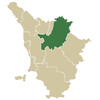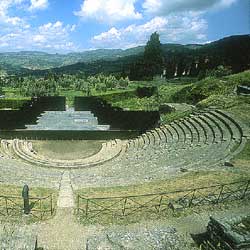|
 Inhabitants in 1991: 15.096 Inhabitants in 1991: 15.096
 The
Municipal territory of Fiesole extends for 42,11 square kilometres in
the Valdarno Fiorentino Hills. Ancient Etruscan settlement, then Roman
Municipality and Medieval Podesta Office, Fiesole reached its present
day aspect in 1910 when the districts of Settignano, Rovezzano, Pellegrino
and part of the districts of Coverciano and Mensola aggregated to its
municipality since 1865 were detached from it to benefit Firenze. The
Municipal territory of Fiesole extends for 42,11 square kilometres in
the Valdarno Fiorentino Hills. Ancient Etruscan settlement, then Roman
Municipality and Medieval Podesta Office, Fiesole reached its present
day aspect in 1910 when the districts of Settignano, Rovezzano, Pellegrino
and part of the districts of Coverciano and Mensola aggregated to its
municipality since 1865 were detached from it to benefit Firenze.
A city founded by the Etruscans - its most ancient archaeological remains
are dated around the VII - VI century B.C. - Fiesole was originally a
military post; its importance in the Etruscan era is demonstrated
today by the imposing remains of the walls. The first historic
record goes back to 225 B.C. when it suffered the invasion of the Galli.
In 80 B.C. Silla gave over great part of the territory to his own legions,
to punish Fiesola who had taken Mario's side. It is from that date
that the Roman city developed and which quickly became a very important
centre (the remains of two gates, the baths and the beautiful Roman theatre
which was returned to use after its restoration at the end of the 1800
can be seen).
 The municipal
decadence started and progressed with the barbaric invasions:
in 405 the Goths, in 540 Belisario re-conquered it after a long siege;
in the Dark Ages the ancient Roman city must have been dilapidated
and the major centre of the town remained around the Abbey, then the
Seat of the Bishop. But above all the development of nearby Firenze
contributed to the decadence, perhaps even before the IX century the
Fiesola country was united to that of Firenze under the head of government
of the province, the Count of Firenze; it is certain that in 1125
in the first important conflict with expansionistic aims by Firenze, they
conquered and destroyed the fortress, subjugating their neighbours with
the military; in 1228 the Bishop of Fiesole, submerged with debts,
incurred by his predecessor with the Firenze lenders, received
resident's licence in a palazzo next to the church of Santa Maria
in Campo in Firenze from Gregorio IX, as many aristocratic
Fiesola families had decided to do for some generations becoming among
the principals of Firenze: the Alfieri, the Adimari, the Caponsacchi,
the Guadagni, and the Scali. Fiesola however, in the late Middle Ages
and in modern times maintained a certain importance (it was Seat of
Office of a Podesta united to Sesto Fiorentino) because of its diocese
whose jurisdiction extended over a vast territory comprising the Val di
Sieve and part of the Casentino, del Valdarno Superiore and Chianti; and
since the XIV century the tendency for staying in "villas" of the
most well to do Fiorentini made its hills with its Lordly buildings
popular, giving the best part of the Fiesola territory an aspect of singular
harmony that has made it famous in all the world. Among Fesola's illustrious
sons are cited the architects Giuliano (1432-90) and Benedetto
da Maiano (1442-97) the engraver Stefano della Bella (1610-64)
and - perhaps because the place "considers itself both stone and rock"-
a long series of sculptors, among which the dynasty of Ferrucci.
A place of deep rooted socialist tradition it gave a notable contribution
to Antifascism and the to the partisan war. Noted is the heroic
episode of three policemen who prevented a cruel reprisal
against the defenceless citizens on 1 September 1944 by being shot themselves.
It is the present day the Seat of important cultural institutes
and of notable artistic manifestations. The municipal
decadence started and progressed with the barbaric invasions:
in 405 the Goths, in 540 Belisario re-conquered it after a long siege;
in the Dark Ages the ancient Roman city must have been dilapidated
and the major centre of the town remained around the Abbey, then the
Seat of the Bishop. But above all the development of nearby Firenze
contributed to the decadence, perhaps even before the IX century the
Fiesola country was united to that of Firenze under the head of government
of the province, the Count of Firenze; it is certain that in 1125
in the first important conflict with expansionistic aims by Firenze, they
conquered and destroyed the fortress, subjugating their neighbours with
the military; in 1228 the Bishop of Fiesole, submerged with debts,
incurred by his predecessor with the Firenze lenders, received
resident's licence in a palazzo next to the church of Santa Maria
in Campo in Firenze from Gregorio IX, as many aristocratic
Fiesola families had decided to do for some generations becoming among
the principals of Firenze: the Alfieri, the Adimari, the Caponsacchi,
the Guadagni, and the Scali. Fiesola however, in the late Middle Ages
and in modern times maintained a certain importance (it was Seat of
Office of a Podesta united to Sesto Fiorentino) because of its diocese
whose jurisdiction extended over a vast territory comprising the Val di
Sieve and part of the Casentino, del Valdarno Superiore and Chianti; and
since the XIV century the tendency for staying in "villas" of the
most well to do Fiorentini made its hills with its Lordly buildings
popular, giving the best part of the Fiesola territory an aspect of singular
harmony that has made it famous in all the world. Among Fesola's illustrious
sons are cited the architects Giuliano (1432-90) and Benedetto
da Maiano (1442-97) the engraver Stefano della Bella (1610-64)
and - perhaps because the place "considers itself both stone and rock"-
a long series of sculptors, among which the dynasty of Ferrucci.
A place of deep rooted socialist tradition it gave a notable contribution
to Antifascism and the to the partisan war. Noted is the heroic
episode of three policemen who prevented a cruel reprisal
against the defenceless citizens on 1 September 1944 by being shot themselves.
It is the present day the Seat of important cultural institutes
and of notable artistic manifestations.
Places to visit:
Archaeological area, where the
major testimonies of the first Etruscan then Roman city are concentrated.
Museum, constructed in 1912 is composed of 8 rooms where
archaeological discoveries coming from the digs in the Fiesola area
are collected.
Cathedral, named for S. Romolo, it was
begun in 1024 to substitute the Cathedral which had risen on the place
of the present day Fiesola Abbey. It was enlarged in 1200 and in 1300.
At the end of 1800 it was radically restored, with the complete reconstruction
of the facade. The three nave basilican interior contains precious
works of art from diverse eras.
Basilica di S. Alessandro,
it is said to have been built in the VI century on a preceding pagan
temple. It was reworked in the IX century, in 1570, in 1782, in 1814
and lastly in 1956. The three nave interior is divided by 16 columns.
S. Francesco, 1300 church initially the oratory of the
convent of Fiorentine Romite, passed then to the Francescani, Restored
in 1905 has a single nave interior with murals . |
Historical info reproduced upon authorization of
Regione Toscana - Dipartimento della Presidenza E Affari Legislativi e
Giuridici
Picture by Sandro Santioli
Translated by Ann Mountford
|